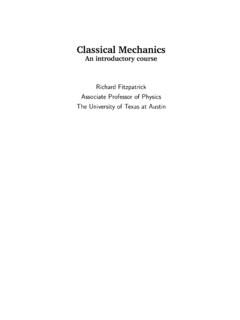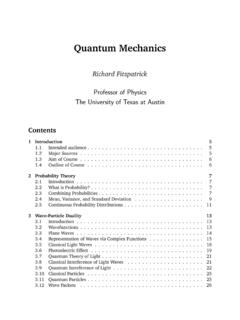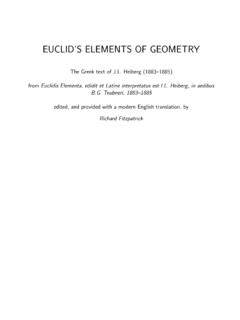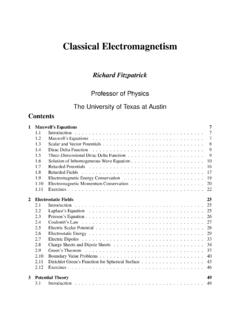Transcription of Thermodynamics and Statistical Mechanics
1 Thermodynamics and Statistical MechanicsRichard FitzpatrickProfessor of PhysicsThe University of Texas at AustinContents1 Why Study Thermodynamics ?.. AtomicTheoryofMatter .. What is Thermodynamics ? .. Classical and Statistical Thermodynamics .. 112 Probability Introduction .. What is Probability? .. Combining Probabilities .. Two-StateSystem .. CombinatorialAnalysis .. Binomial Probability Distribution .. Mean,Variance,andStandardDeviation .. Application to Binomial Probability Distribution .. Gaussian Probability Distribution .. CentralLimitTheorem .. 263 Statistical Introduction.
2 Principle of Equal A Priori Probabilities .. Reversibility and Probability Calculations .. 394 Heat and MacrostatesandMicrostates .. Exact and Inexact Differentials .. 515 Statistical Introduction .. ThermalInteractionBetweenMacrosystems .. MechanicalInteractionBetweenMacrosystems .. GeneralInteractionBetweenMacrosystems .. Entropy .. PropertiesofEntropy .. UsesofEntropy .. Laws of Thermodynamics .. 736 Classical Introduction .. IdealGasEquationofState .. CalculationofSpecificHeats .. IsothermalandAdiabaticExpansion .. Hydrostatic Equilibrium of Atmosphere.
3 IsothermalAtmosphere .. InternalEnergy .. HelmholtzFreeEnergy .. Joule-Thompson Throttling .. Applications of Statistical Introduction .. Canonical Probability Distribution .. Spin-1 SystemwithSpecifiedMeanEnergy .. Partition IdealMonatomicGas .. Gibb Equipartition Theorem .. Harmonic Oscillators .. SpecificHeats .. SpecificHeatsofGases .. MaxwellVelocityDistribution .. Effusion .. Quantum Introduction .. FormulationofStatisticalProblem .. Bose-EinsteinStatistics .. DerivationofvanderWaalsEquationofState .. Stefan-BoltzmannLaw.
4 Conduction Electrons in SommerfeldExpansion .. ChandrasekharLimit .. NeutronStars .. Bose-Einstein Condensation .. Multi-Phase Introduction .. Equilibrium of Isolated Equilibrium of Constant-Temperature System .. Equilibrium of Constant-Temperature Constant-Pressure Stability of Single-Phase Substance .. Equilibrium Between Phases .. PhaseDiagrams .. Physical Constants251B Classical GeneralizedForces .. Lagrange ConditionalVariation .. Multi-Function Variation .. Hamilton Hamilton sEquations ..262C Wave Introduction .. Photoelectric Effect .. Electron Diffraction.
5 RepresentationofWavesviaComplexNumbers .. Schr odinger sEquation .. Probability Interpretation of Wavefunction .. WavePackets .. Heisenberg Simple Harmonic Oscillator .. Angular Momentum ..2836 CONTENTSI ntroduction71 Intended AudienceThese lecture notes outline a single-semester course intended for upper-division physics Major SourcesThe textbooks that I have consulted most frequently while developing course material are:Fundamentals of Statistical and Thermal Physics:F. Reif (McGraw-Hill, New York NY, 1965).Introduction to Quantum Theory:D. Park, 3rd Edition (McGraw-Hill, New York NY, 1992).Classical and Statistical Carter (Prentice-Hall, Upper Saddle River NJ,2001).
6 Why Study Thermodynamics ?In a nutshell, Thermodynamics is the study of the internal motions of many-body systems. Virtu-ally all physical entities that we encounter in everyday life are many-body systems of some type orother ( , solids, liquids, gases, and even electromagnetic radiation). Not surprisingly, therefore, Thermodynamics is a discipline with an exceptionally wide range of applicability. Indeed, ther-modynamics is one of the most extensively used subfields of physics outside physics engineers, chemists, and material scientists generally do not study relativity or particlephysics, but Thermodynamics is an integral, and very important, part of their degree people are drawn to physics because theywish to understand why the world around us islike it is.
7 For instance, why the sky is blue, why raindrops are spherical, why we do not fall throughthe floor, et cetera. It turns out that Thermodynamics is a very powerful tool for accounting for theobserved features of the physical world. For example, in this course, we shall explain why heatspontaneously flows from hot to cold bodies; why it is impossible to measure a temperature below-273 centigrade; why there is a maximum theoretical efficiency of a power generation unit that cannever be exceeded, no matter what the design; why the Earth s atmosphere becomes thinner andcolder at higher altitudes; why the Sun appears yellow , whereas colder stars appear red, and hotterstars appear bluish-white.
8 And why high mass stars must ultimately collapse to form Atomic Theory of MatterAccording to the well-knownatomictheory of matter, the familiar objects that make up the worldaround us, such as tables and chairs, are themselves made up of a great manymicroscopic What is Thermodynamics ?Atomic theory was invented by the ancient Greek philosophers Leucippus and Democritus,who speculated that the world essentially consists of myriads of tiny indivisible particles, whichthey calledatoms, from the Greekatomon, meaning uncuttable. They speculated, further, that theobserved properties of everyday materials can be explained either in terms of the differentshapesof their constituent atoms, or the differentmotionsof these atoms.
9 In some respects, modern atomictheory differs substantially from the primitive theory ofLeucippus and Democritus. However, thecentral ideas have remained essentially unchanged. In particular, Leucippus and Democritus werecorrect to suppose that the properties of materials depend not only on the nature of their constituentatoms or molecules, but also on the relative motions of these What is Thermodynamics ?In this course, we shall focus almost exclusivelyon those physical properties of everyday materialsthat are associated with themotionsof their constituent atoms or molecules. In particular, we shallbe concerned with the type of motion that we normally call heat.
10 We shall try to establish whatcontrols the flow of heat from one body to another when they are brought into thermal contact. Weshall also attempt to understand the relationship between heat and mechanical work. For instance,to what extent does the heat content of a body increase when mechanical work is done on it? Moreimportantly, can we extract heat from a given body in order to do useful work on some other body?This subject area is called Thermodynamics , from the Greek rootsthermon, meaning heat, anddunamis, meaning power. Need for Statistical ApproachIt is necessary to emphasize, from the very outset, that Thermodynamics is a difficult subject.






